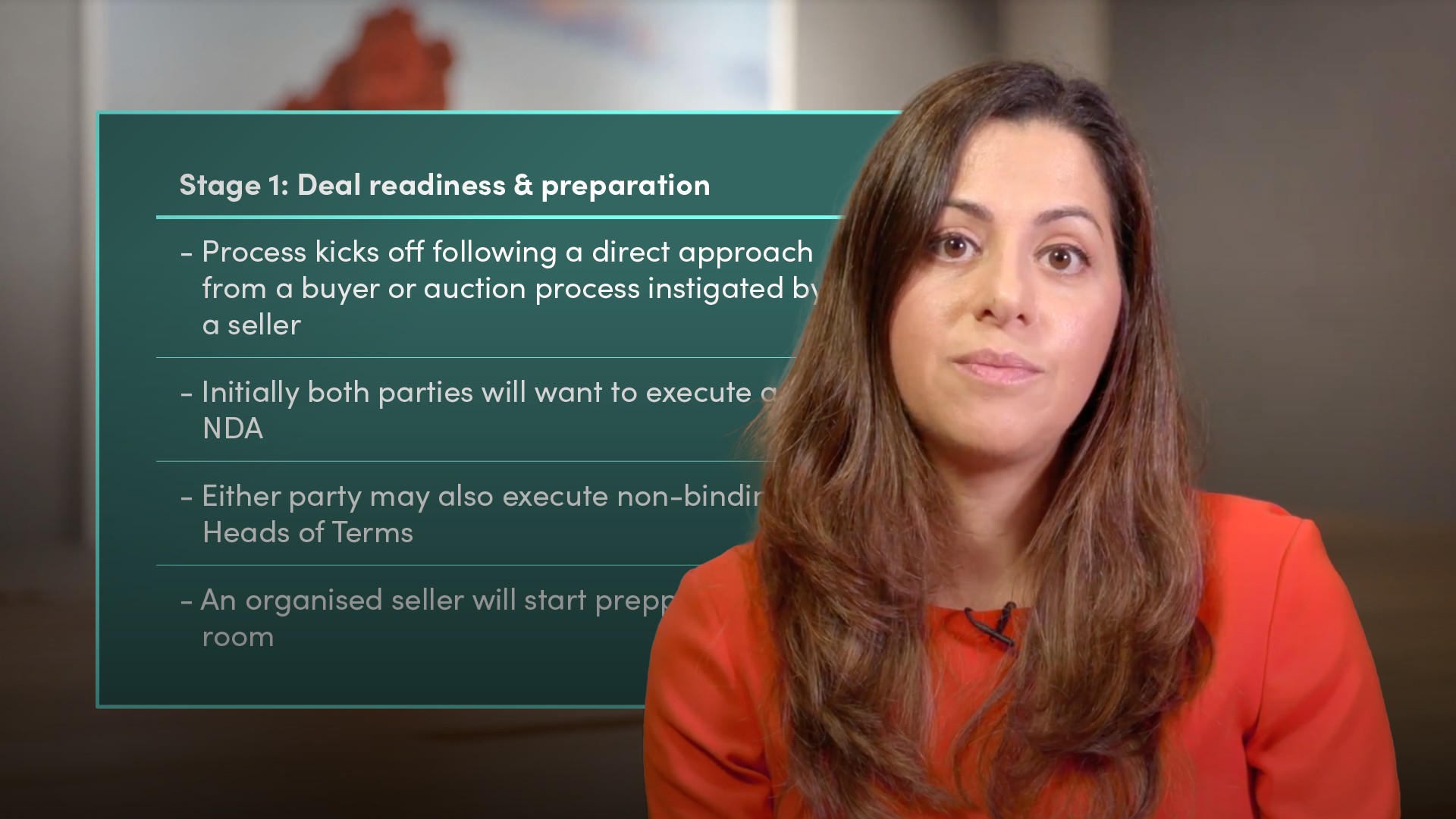
Legal Considerations in a M&A transaction

Elvan Hussein
15 years: M&A legal
Mergers and acquisitions, commonly referred to as M&A, are transactions where a company's shares, or its entire business, is sold or merged with another company. Elvan explains why companies engage in an M&A transaction before describing the key steps in the timetable and documentation required.
Mergers and acquisitions, commonly referred to as M&A, are transactions where a company's shares, or its entire business, is sold or merged with another company. Elvan explains why companies engage in an M&A transaction before describing the key steps in the timetable and documentation required.
Subscribe to watch
Access this and all of the content on our platform by signing up for a 7-day free trial.

Legal Considerations in a M&A transaction
7 mins 58 secs
Key learning objectives:
Define a M&A Transaction
Outline the five stages of a M&A transaction
Understand the reasons a company would engage in a M&A transaction and the objectives of each party
Overview:
Engaging in a merger or acquisition can be beneficial for both the buyer and seller, although these benefits may be different. As both parties are getting something different out of the deal, they will approach the negotiation with different objectives. The negotiation, or Transactional Documentation, is only one of five stages of a M&A process: Deal Readiness & Preparation, Due Diligence & Risk Management, Transactional Documentation, Execution & Completion, and Post-completion Integration.
Subscribe to watch
Access this and all of the content on our platform by signing up for a 7-day free trial.
What is a M&A Transaction?
M&A stands for "Mergers and Acquisitions". Mergers and acquisitions are transactions where a company's shares, or its business, is sold or merged with another company.Why would a company engage in a M&A transaction?
A seller may decide to dispose of a business for a number of reasons, these may include:
- A need to raise cash or working capital
- An attempt to divert attention from bad results
- The divestment of a non-core business or underperforming assets within the business
- Realising an investment that they have made
- Creating distributable reserves to pay dividends
A purchaser may look to acquire a business to:
- Bring facilities or support in-house
- Acquire a revenue stream and as a result achieve non-organic growth for speed
- Enter a new market or consolidate market share
- Acquire a competitor, brand or specific asset
- Divert attention from bad results
What is a typical M&A process?
The M&A process may broadly be characterised into five stages:
- Phase 1: Deal Readiness & Preparation
- The process begins with a direct approach from a potential buyer, a 'fishing exercise', or auction process instigated by a seller, looking to identify a buyer to sell to
- The signing of a Non-Disclosure Agreement (NDA or confidentiality agreement)
- The buyer and seller may also execute non-binding Heads of Terms, outlining the key terms on which they are prepared to conclude the transaction
- An organised seller will start preparing a Data Room - a location used for storing data relating to the target business
- Phase 2: Due Diligence & Risk Management
- Buyer carries out due diligence on the target business - this is the process pursuant to which the buyer will conduct a detailed review of the target’s business to assess whether it is worthy of purchasing at the price
- At a minimum, a buyer will want to carry out legal and financial (or commercial) due diligence on the target business. This due diligence will include an assessment of all information on the target business made available by the seller in a 'Data Room'
- The buyer, and advisors, prepare a list of specific due diligence questions that it has for the seller
- Phase 3: Transactional Documentation
- The parties will start negotiating the transaction documents to implement the transfer of the target business. The key transaction documents in an M&A transaction are:
- The Sale and Purchase Agreement (SPA) - sets out the terms of the transaction
- Disclosure Letter - determines whether a disclosure (i.e. an exception to the warranty) needs to be made
- The parties will start negotiating the transaction documents to implement the transfer of the target business. The key transaction documents in an M&A transaction are:
- Phase 4: Execution and Completion
- Execution of the transaction documents and completion - this will occur simultaneously unless there are conditions to completion (such as obtaining regulatory approvals)
- Phase 5: Post-completion Integration
- The buyer will look to take steps to integrate the newly acquired target business into its existing business. This will involve integrating systems
What are the objectives of the parties in executing a M&A transaction?
When considering how to structure or document a transaction, the seller will typically have the following key objectives:
- Disposing of all of their liabilities and risks associated with the target business
- Transaction certainty with no conditionality linked to the transaction
- Minimise the risk of a claim by the buyer against them in respect of the acquired business
- Maximise the purchase price that it receives for the target business - therefore, no price adjustment mechanisms or any contingency on the financial performance
A buyer, on the other hand, will be concerned with:
- Obtaining unencumbered, clean ownership of the target business and all assets
- Taking on as few liabilities as possible
- Retain management and staff
- Minimise disruption
- Minimise the purchase price
Subscribe to watch
Access this and all of the content on our platform by signing up for a 7-day free trial.

Elvan Hussein
There are no available Videos from "Elvan Hussein"



























